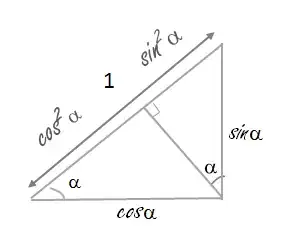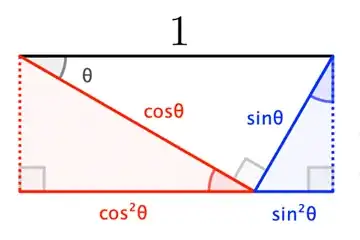This is a great question. The original proof-as-I-read-it is valid, but some proofs can be "better" or worse in other respects. (By "as I read it", I mean with the implication that it calculates projections with similar triangles as I describe below, rather than stating their values without proof.) There are many criteria for saying one proof is "better" than another, so I'll focus on one germane to this question: making it obvious to all readers that there's no circularity (spoiler alert: there isn't).
Let the legs adjacent to and opposite $\alpha$ have respective lengths $a,\,b$,and let $c$ denote the hypotenuse's length. By similar triangles, your projections are $c(a/c)^2,\,c(b/c)^2$. Since they sum to the full hypotenuse $c$, $a^2+b^2=c^2$.
Since we define $\cos\alpha,\,\sin\alpha$ respectively as $a/c,\,b/c$, the above calculation can be restated as$$c\cos^2\alpha+c\sin^2\alpha=1\implies c(a/c)^2+c(b/c)^2=1\implies a^2+b^2=c^2,$$which is basically what your proof does. (It takes $c=1$ throughout, but that just changes the units to tidy the algebra; it's not an extra assumption as such, so it covers the general case.) But as I've shown above, there's no need to work with anything other than rational functions of $a,\,b,\,c$. The trigonometric approach switches from such rational functions to something more conceptually advanced, then "uninstalls" the trigonometry later.
One could argue this is a worse proof than the one I've presented, because in taking unnecessary detours it not only asks more of us, it also obscures the underlying reasoning. Well, whether it does is a psychological question, but people mistakenly thinking it's circular suggests as much.
Well, I want to be fair with an edit: as best I can tell from recent comments, those people either didn't realize which proof strategy is implicit in the OP's discussion of projections, or are making the actually salient point that the drawing itself doesn't necessarily communicate that as clearly as one would like in a proof without words. But the facts are these:
- the proof can easily be spelled out in the aforementioned non-circular way,
- it takes a bit more work to do that than is obtained in at least some readings of the picture and the text above it, and
- none of these subtleties matter if we skip the trigonometry altogether, as aforesaid.


 $(a+b) \times (a+b) $ square" />
$(a+b) \times (a+b) $ square" />